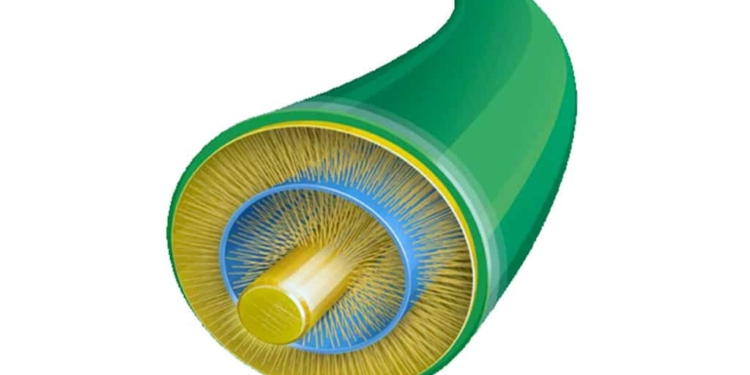Source: Capacitech Energy datasheet
The CBC Cable Based Capacitor is a new type of Capacitor which is built on the surface of a wire. This unique form factor provides many new advantages.
Capacitech Energy, LLC (Capacitech) was launched to spin out technology from the University of Central Florida. Funded by the National Science Foundation SBIR/STTR program, our focus is currently on Cable-Based-Capacitor (CBC) technology. The CBC’s unique form factor offer’s a variety of advantages to distributors, designers, and manufacturing companies.
CBC Series
Capacitors come in so many shapes and sizes of a variety of different performances. With energy storage chemicals sandwiched between two concentric electrodes, the CBC is the first capacitor built in the form factor of a wire or cable.

A traditional capacitor has two conductive plates. One acts as the positive electrode and the other acts as the negative. The separation of the two plates creates an electric field. Adding energy storage materials between these plates will enhance the energy storing ability of the capacitor.
The CBC capacitor is a little different than a traditional capacitor in the sense that it is separated by two concentric plates rather than two parallel plates. Because it is radial rather than planar, the CBC’s surface area is increased by pi (3.14) times. Traditional capacitor equations and characteristics still work too.
The CBC’s voltage and capacitance can be easily customized by the electronics distributor, manufacturer or designer, leading to flexibility and reduced lead times. It is thin, flexible, features an ESR of ~0.2 ohms, retains its charge with a leakage current of ~0.3mA, has a temperature range between +10 to +65 degrees Celsius, and offers a traditional capacitor response to varied frequencies.
The CBC can be used like a super capacitor or a traditional electrolytic capacitor. I
The CBC is thin, tough, and flexible. Need to make a connection blocked by another copper trace? The CBC can connect on different ends of the PCB if needed. Need to fit a large capacitor inside a small case? Fold the CBC in half. Don’t have room for a capacitor that is needed? Put it in the power cord!
Features
- Easily customizable voltage & capacitance
- Low lead times
- Thin & Flexible
- High power density
- Helps reduce PCB size
- Flash systemsBackup power systems (UPS)
- Peak Power Assist
- Wireless Alarms & IoT
- Energy Harvesting
- Toys & Games
Q: Can the CBC be a surface mount device?
A: No. It can be soldered onto a surface mount pad if needed. There is not room in the budget at this time to develop robotics that would be needed to make the CBC a surface mount device. The CBC is designed to replace capacitors with a large capacitance value which are typically large in size, through-hole, and often still installed by hand. The CBC is intended, at this point, to replace capacitors in the uF and mF range. Surface mount compatible capacitors are often in pF range which would be too small for the CBC.
Q: How many capacitors can you replace in respect to the market? What fraction can you cover?
A: The CBC is currently rated for 3.2V and 40mF per cm. This size capacitor would be compatible to replace and add advantages to approximately 1/8 of the capacitors on market. At this stage, it is a niche market, however many industry experts have urged us to launch this product to get it out there and generate revenue while developing a CBC rated to 50V which would be capable of replacing about 1/3 market. In the pF range, the resolution of capacitors is higher (i.e 1pF, 2 pF, 3 pF, etc…) whereas the uF and mF range the resolution is lower (i.e 10uF, 100uF, 320uF, 680uF, 820uF, etc…)
Customization & Performance Breakdown
10cm CBC
10cm – 1.6V – 2F
20 cm – 3.2V – 1F
30cm = 4.8V – 0.67F
40cm – 6.4V – 0.50F
5cm CBC
5cm – 1.6V – 1F
10 cm – 3.2V – 0.5F
15cm = 4.8V – 0.33F
20cm – 6.4V – 0.25F
1cm CBC
1cm – 1.6V – 0.2F
2 cm – 3.2V – 0.1F
3cm = 4.8V – 0.067F
4cm – 6.4V – 0.050F
































